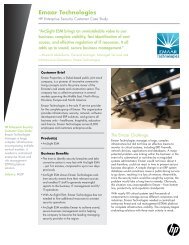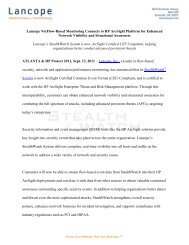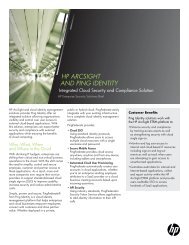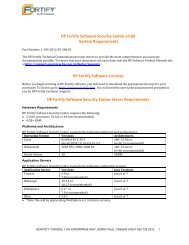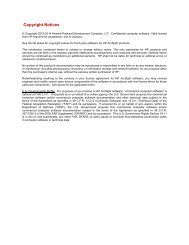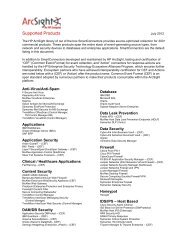HP 2012 Cyber Risk Report
HP 2012 Cyber Risk Report
HP 2012 Cyber Risk Report
- No tags were found...
You also want an ePaper? Increase the reach of your titles
YUMPU automatically turns print PDFs into web optimized ePapers that Google loves.
White paper | <strong>HP</strong> <strong>2012</strong> <strong>Cyber</strong> <strong>Risk</strong> <strong>Report</strong>Figure 11. Allowing unvalidated user uploads can have severe consequencesUnvalidateduseruploadsNo antimalwareprotectionInfect30,000users withmalwareFigure 12. Blind SQL InjectionSystemadministrationaccessBlind SQL injection: Guided search functionality (a series of checkboxes designed to helpconsumers narrow down their search criteria) without input validation resulted in the exposureof 35 databases and database system user IDs and password hashes, including the systemadministrator account. Blind SQL injection can be difficult to find because it rarely reveals errormessages and manifests itself as anomalous application behavior. Parameterized queries,also known as prepared statements, effectively prevent SQL injection attacks when properlyimplemented. 5 Figure 12 shows this sequence.Blind SQLinjectionUserinformationtheftCleartext SQL: During testing of a thick client application, it was discovered that the clientwas executing SQL statements directly to the back-end SQL server with administrator-levelpermissions over HTTP. By reverse engineering the protocol and through manipulation, userprivilege escalation and password modification was achieved (see Figure 13).Figure 13. Cleartext SQLPasswordreset usingelevatedprivilegeReverse engineerclient/serverprotocolSQL executionFigure 14. Failure to restrict accessUnrestricted directory accesshttps://www.example.com/passwords/ {Directory}passwrds.projectpasswords.systems {File}user:passwordsysadmin:{password}Local file inclusion: Directory traversal and local file inclusion techniques were used to viewthe contents of the Web server’s backup security accounts manager (SAM) file, which allowedthe passwords to be cracked. Within 10 minutes, local administrator access to the system wasgained, allowing for complete compromise. Input validation routines, both inherent within theapplication and at the Web server configuration level, would have eliminated this vector.Security misconfiguration hacksIndustries: petrochemical and international bankingFailure to restrict access to sensitive directories: In this case, the discovered directory was“https://www.example.com/passwords/”. Understandably, there shouldn’t be a “passwords”folder, at least not publicly. The folder was accessible via Web browsers with no authenticationand included a directory listing of text files with names like “passwords.project”, including“passwords.systems”. Clicking on a file opened a text document with a list of users andpasswords in the format: user:password. One of the lists even contained “sysadmin:{password}admin:{password} etc…” (see Figure 14). This illustrates the need for and the importanceof post-automated scan validation, as this seemingly low-risk vulnerability could easily bedisregarded by the customer. In addition, the problem could have been avoided if access to thedirectory had been properly restricted.WebDAV enabled allowing remote write: WebDAV was enabled on a particular Web server ina way that allowed remote application users to interact with the host and write files to arbitrarydirectories. By leveraging this vulnerability, a custom backdoor was uploaded and subsequentlyexecuted by browsing to the URL path of the newly transferred file. Once executed, it allowedfull control of the Web server. If scoped for further testing, the tester would have been able tocontinue the attack against other hosts on the internal corporate network—a process knownas pivoting. Removing WebDAV access and extraneous HTTP methods could have preventedthis attack.SQL injection and weak input validation controls: A SQL filter was filtering everything butthe “OR” operator. This basically means that by including “OR” in a SQL statement that anycommand after it would be executed on the system. Parameterizing queries will prevent SQLinjection attacks. Figure 15 breaks down the sequence of a SQL injection attack.5 https://www.owasp.org/index.php/SQL_Injection_Prevention_Cheat_Sheet12



